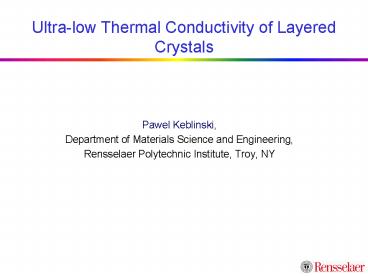Ultralow Thermal Conductivity of Layered Crystals - PowerPoint PPT Presentation
1 / 20
Title:
Ultralow Thermal Conductivity of Layered Crystals
Description:
Ultra-low Thermal Conductivity of Layered Crystals. Pawel Keblinski, ... Alumina. copper. diamond. YSZ. Phonons Phonons electrons Phonons = 1/3 c v ... – PowerPoint PPT presentation
Number of Views:169
Avg rating:3.0/5.0
Title: Ultralow Thermal Conductivity of Layered Crystals
1
Ultra-low Thermal Conductivity of Layered Crystals
- Pawel Keblinski,
- Department of Materials Science and Engineering,
- Rensselaer Polytechnic Institute, Troy, NY
2
People
Arun Bodapati - graduate student Lin Hu -
graduate student Sergei Shenogin - postdoctoral
researcher David Cahill - University of Illinois
at Urbana
3
Intro to Thermal Conduction - Materials
Perspective
4
Heat conduction range
Thermal conductivity W/m-K 1 10 100
1000
aSi
cSi
YSZ
Alumina
diamond
Isotropic polymers
copper
Phonons Phonons electrons
Phonons
Most of the variation comes from the mean free
path of the carrier
? 1/3 c ? v
Thermal conductivity
Phonon velocity
Mean free path
Heat capacity
5
Mean free path and minimum thermal conductivity
Phonon-phonon scattering
- Silicon at 300K
- Mean free path L 100nm
- Polysilicon
- L few times grain size
- Amorphous Si
- atom size
- Einstein limit
- Minimum thermal conductivity
? 100 W/m-K
Phonon-grain boundary
No real propagating phonons
? 1 W/m-K
6
Thermal conductivity temperature dependence
Amorphous and nanocrystals
Crystal
- At low temperatures tc increases with increasing
heat capacity - At higher temperature phonon-phonon scattering
lowers mean free - Newly excited high frequency phonons doe not
contribute much to tc
- Phonon mean free path atom size or grain size
- Thermal conductivity increases with temperature
7
Ultra-low Thermal Conductivity of
LayeredMaterials
8
Below the amorphous material limit
Thermal conductivity below the Einstein limit Why
it is so low? Is it really below Einstein limit?
C. Chiritescu, D. G. Cahill, et al., Science.
315, 353(2007).
9
How to go below the amorphous material limit
- Find a crystal with low thermal conductivity to
start with - Create nanostructures possibly reducing already
low thermal conductivity by 1-2 orders of
magnitude - By creating poly/nanocrystals
- By creating superlattices
10
Model structures
A B A B A B A
B A B
Perfect crystal Stacking disorder Grain
boundaries Mass superlattice
A C A B C B A
B A B
11
Model interactions
Harmonic springs
Lennard-Jones potential
- Two sets of ? and ? parameters are used
- Within WSe2 sheet ? 0.455 eV and ? 2.31 Å
- Between layers ? 0.04 eV and ? 3.4 Å
12
Molecular dynamics results
Perfect crystal and stacking disordered
structures show strong film thickness dependence
not observed in experiment Structures with grain
boundaries show lower conductivity and weaker
size dependence
13
Phonon Localization and Polarization
Perfect crystal
Low frequency phonons are delocalized and
polarized
Higher frequency phonons are delocalized but not
well polarized
14
Phonon Localization and Polarization
Stacking disorder
Low frequency phonons are delocalized and
polarized, same way as in perfect crystal
Higher frequency phonons can be localized or
delocalized but they do not matter much for
thermal transport
15
Phonon Localization and Polarization
Grain boundary
Low frequency phonons are weakly localized and
weakly polarized
Conductivity reduction and weak size dependence
Higher frequency phonons can be localized or not
and are not polarized
16
Phonon Localization and Polarization
Mass disorder
Modes exhibit features of superlattice
periodicity and are delocalized
Thermal conductivity of a dense solid below that
of still air Perhaps the reduction of tc is akin
to that observed in semiconductor superlattices
17
A Simple Interfacial Model
- Nano-structuring eliminates propagating phonons
- Therefore, one can consider the structure as a
series of independent interfaces characterized by
interfacial their thermal resistance/conductance
- Each layer is a 2 d crystal with phonons
propagating in-plane - Heat flow between planes is proportional to
number of in-plane phonons with frequency below a
threshold determined by strength of cross plane
interactions. - Under assumptions 1-4 a simple analysis yields
thermal conductance
18
Phonon Perspective
WSe2 cross-plane acoustic branches
Only cross-plane longitudinal acoustic (LA)
branch has a significant group velocity Transverse
acoustic (TA) branch has very low group velocity
19
Phonon Perspective
WSe2 cross-plane and in-plane branches
Cross-plane optical branches have essentially
zero group velocities
20
Minimum Thermal Conductivity
- If you assume that there is the same group
velocity for all branches c cLA, where cLA is
the cross plane speed of sound you overestimate
by - A factor of 3 since cLA gtgt cTA
- A factor cLA/ cLA(in plane) due to elastic
anisotropy - Thus for WSe2 the overestimate will be about
factor of 5-4
Correct application of the minimum thermal
conductivity model is in agreement with the
experiment































